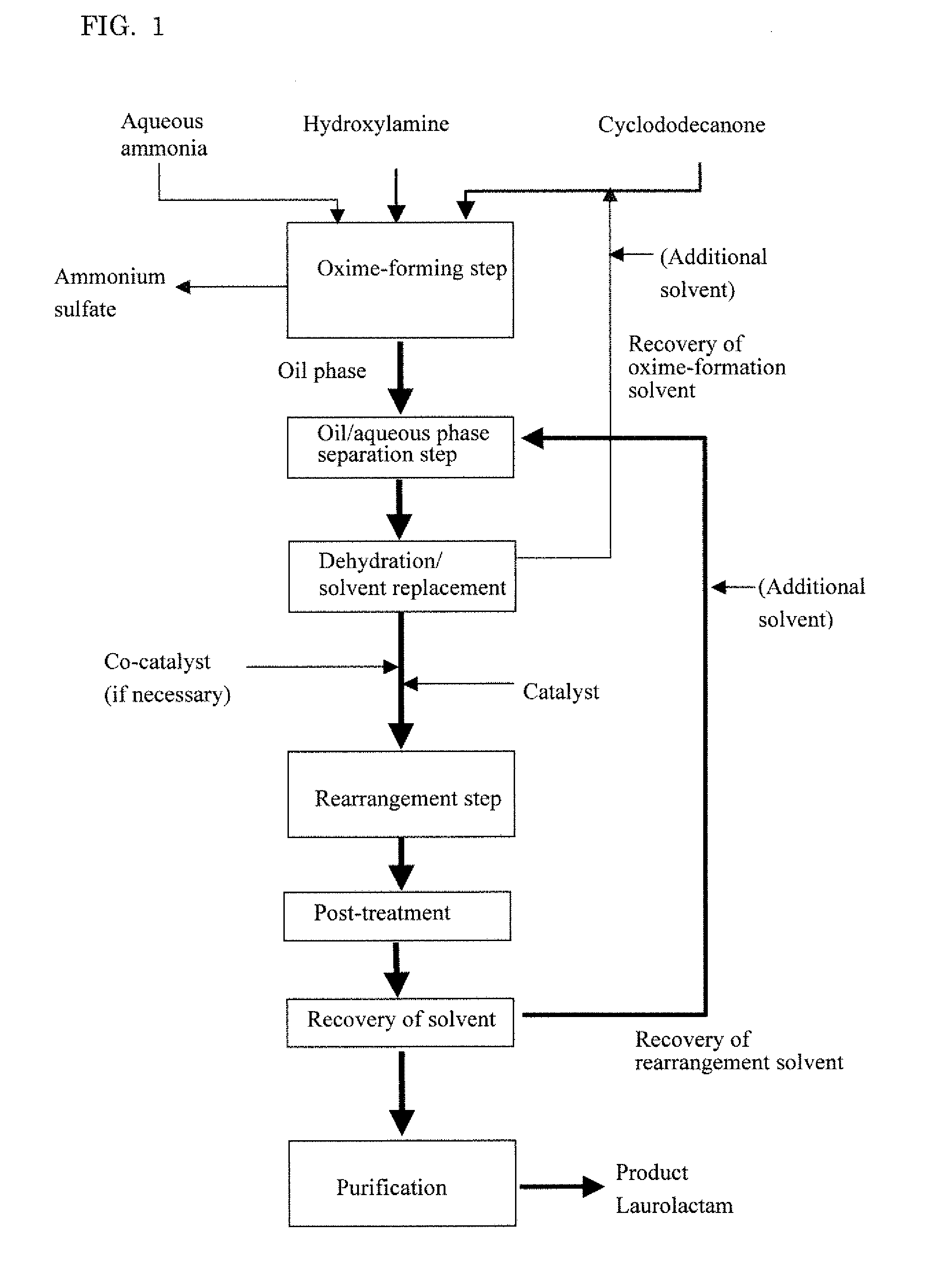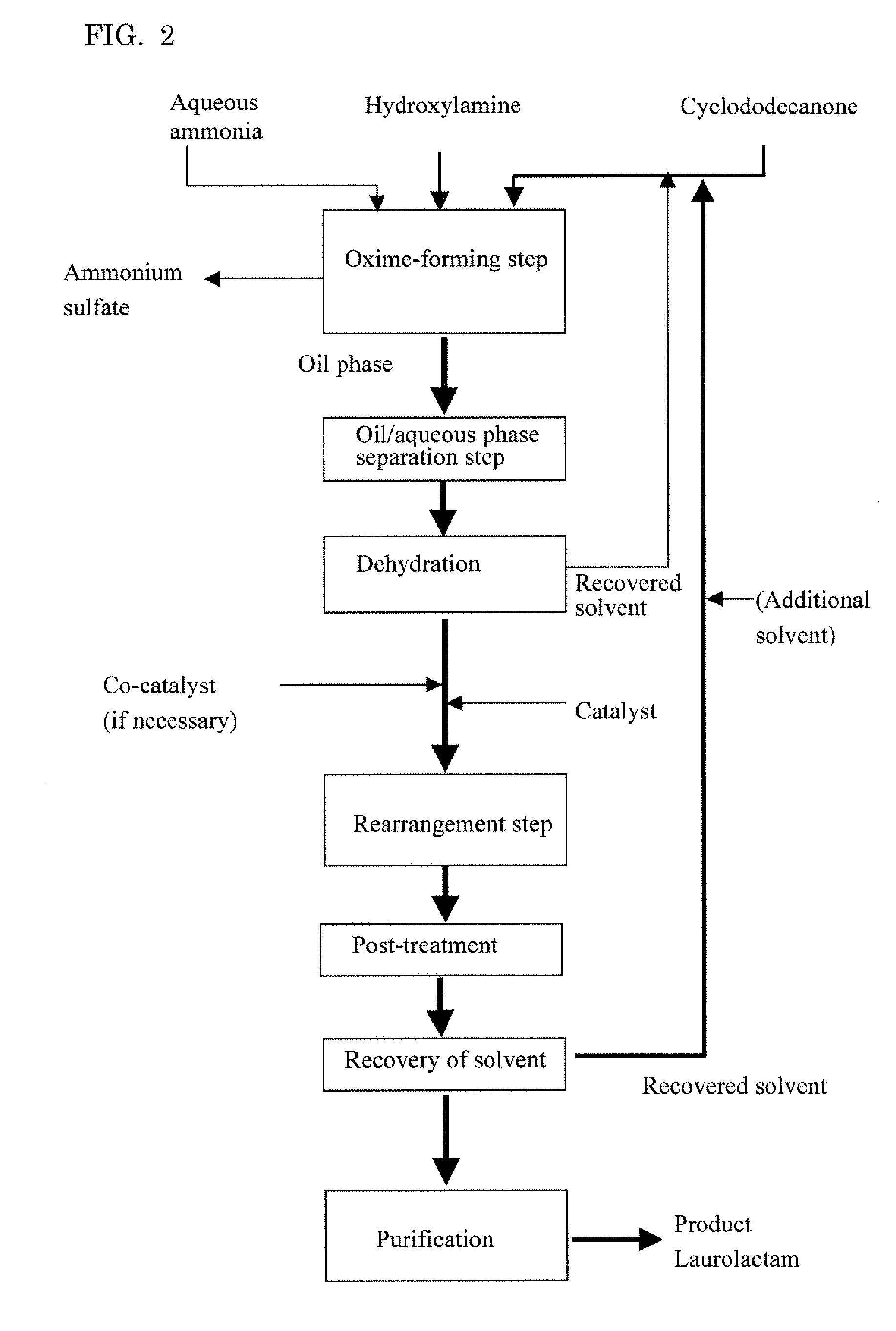Process for producing laurolactam
a technology of laurolactam and process, which is applied in the field of process for producing laurolactam, can solve the problems of large amount of treatment facilities and energy, large processing facilities, and complex process, and achieve the effects of convenient processing of laurolactam, high yield and easy collection
- Summary
- Abstract
- Description
- Claims
- Application Information
AI Technical Summary
Benefits of technology
Problems solved by technology
Method used
Image
Examples
example 1
Oxime-Forming and Oil / Aqueous Phase Separation Steps
[0091]Into a pillow type first reactor for oxime-formation with a 30 L liquid phase zone which was internally divided into four chambers each of which was equipped with an agitating blade were fed a 15% by weight aqueous solution of hydroxylamine sulfate (Wako Pure Chemical Industries, Ltd.) at 3 kg / h and the oil phase from a second reactor for oxime-formation. The reaction temperature was set at 80° C. and 25% by weight of aqueous ammonia was fed into each chamber at 63 g / h to carry out the oxime formation reaction. The reaction mixture was separated into phases of liquid after toluene was added at 1 kg / h, and the oil phase composed of cyclododecanone, 2-propanol and toluene was transferred to the dehydration / solvent preparation step while the aqueous phase was fed into the second rector for oxime formation. The second rector for oxime formation was a 15 L pillow type rector which was internally divided into four chambers, and to ...
example 2
[0101]The reaction was carried out in a similar manner to Example 1 except that the feeding rate of 3% by weight solution of trichlorotriazine in toluene at the rearrangement step was changed to 330 g / h, and additionally 10% by weight of zinc chloride in toluene / laurolactam solution (the ratio of toluene / laurolactam is 111 (weight / weight)) was fed at 75 g / h. The yield of laurolactam until the rearrangement step was 97.5%, yield of laurolactam after distillation was 96.0% and its purity was 99.98%.
example 3
[0102]After the oxime-formation reaction was carried out in a similar manner to Example 1 except that the feeding rates of cyclododecanone / (2-propanol, toluene) solution, hydroxylamine aqueous solution and aqueous ammonia at the oxime-forming step was doubled and the reaction temperature was 95° C., the dehydration and solvent replacement were carried out. While unreacted cyclododecanone was not detected in the residual liquid after the solvent replacement, 90 ppm of water and 50 ppm of 2-propanol were detected.
[0103]The reaction was carried out in a similar manner to Example 2 except that the feeding rates of the cyclododecanone oxime solution obtained in the solvent replacement step, trichlorotriazine solution and the zinc chloride solution was doubled and the reaction temperature was 100° C. After washing with water and aqueous sodium hydroxide each in an amount of twice of Example 2, distillation and purification were carried out. The yield of laurolactam until the rearrangement...
PUM
 Login to View More
Login to View More Abstract
Description
Claims
Application Information
 Login to View More
Login to View More - R&D
- Intellectual Property
- Life Sciences
- Materials
- Tech Scout
- Unparalleled Data Quality
- Higher Quality Content
- 60% Fewer Hallucinations
Browse by: Latest US Patents, China's latest patents, Technical Efficacy Thesaurus, Application Domain, Technology Topic, Popular Technical Reports.
© 2025 PatSnap. All rights reserved.Legal|Privacy policy|Modern Slavery Act Transparency Statement|Sitemap|About US| Contact US: help@patsnap.com



